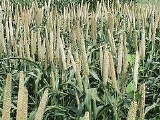
Millet
Encyclopedia
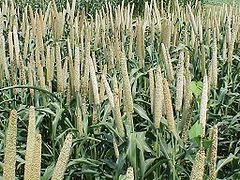
Seed
A seed is a small embryonic plant enclosed in a covering called the seed coat, usually with some stored food. It is the product of the ripened ovule of gymnosperm and angiosperm plants which occurs after fertilization and some growth within the mother plant...
ed species
Species
In biology, a species is one of the basic units of biological classification and a taxonomic rank. A species is often defined as a group of organisms capable of interbreeding and producing fertile offspring. While in many cases this definition is adequate, more precise or differing measures are...
of cereal
Cereal
Cereals are grasses cultivated for the edible components of their grain , composed of the endosperm, germ, and bran...
crops
Crop (agriculture)
A crop is a non-animal species or variety that is grown to be harvested as food, livestock fodder, fuel or for any other economic purpose. Major world crops include maize , wheat, rice, soybeans, hay, potatoes and cotton. While the term "crop" most commonly refers to plants, it can also include...
or grains, widely grown around the world for food
Food
Food is any substance consumed to provide nutritional support for the body. It is usually of plant or animal origin, and contains essential nutrients, such as carbohydrates, fats, proteins, vitamins, or minerals...
and fodder
Fodder
Fodder or animal feed is any agricultural foodstuff used specifically to feed domesticated livestock such as cattle, goats, sheep, horses, chickens and pigs. Most animal feed is from plants but some is of animal origin...
. They do not form a taxonomic group, but rather a functional or agronomic one. Their essential similarities are that they are small-seeded grass
Poaceae
The Poaceae is a large and nearly ubiquitous family of flowering plants. Members of this family are commonly called grasses, although the term "grass" is also applied to plants that are not in the Poaceae lineage, including the rushes and sedges...
es grown in difficult production environments such as those at risk of drought. They have been in cultivation in East Asia
East Asia
East Asia or Eastern Asia is a subregion of Asia that can be defined in either geographical or cultural terms...
for the last 10,000 years.
Millet varieties

Panicoideae
Panicoideae is a subfamily of the true grass family. It probably constitutes two well-distinct lineages, the Andropogonodae and the Panicodae, which are further subdivided into tribes and subtribes...
, of the grass family Poaceae
Poaceae
The Poaceae is a large and nearly ubiquitous family of flowering plants. Members of this family are commonly called grasses, although the term "grass" is also applied to plants that are not in the Poaceae lineage, including the rushes and sedges...
. The exceptions, finger millet and teff, are in the subfamily Chloridoideae
Chloridoideae
Chloridoideae is a subfamily of the true grass family . The systematics of the main group of genera is in need of revision; they are traditionally divided into several tribes like the Eragrostideae....
. The most widely cultivated species in order of worldwide production are:
- Pearl milletPearl milletPearl millet is the most widely grown type of millet. Grown in Africa and the Indian subcontinent since prehistoric times, it is generally accepted that pearl millet originated in Africa and was subsequently introduced into India. The center of diversity, and suggested area of domestication, for...
(Pennisetum glaucum) (Also known as Bajra in India, and as Kambu in Tamil) - Foxtail milletFoxtail milletFoxtail millet is the second most widely planted species of millet, and the most important in East Asia. It has the longest history of cultivation among the millets, having been grown in China since sometime in the sixth millennium BC...
(Setaria italica) (Also known as Thinai in Tamil) - Proso milletProso milletProso millet is also known as common millet, hog millet or white millet. Both the wild ancestor and the location of domestication of proso millet are unknown, but it first appears as a crop in both Transcaucasia and China about 7,000 years ago, suggesting that it may have been domesticated...
, common millet, broom corn millet, hog millet or white millet (Panicum miliaceum) - Finger milletFinger milletEleusine coracana, commonly Finger millet , also known as African millet or Ragi is an annual plant widely grown as a cereal in the arid areas of Africa and Asia. E...
(Eleusine coracana) (Also known as Ragi or Mandwa in India, and as Kezhvaragu in Tamil)
Minor millets include:
- Indian barnyard milletEchinochloa frumentaceaEchinochloa frumentacea is a species of Echinochloa. Both Echinochloa frumentacea and Echinochloa esculenta are called "Japanese millet". This millet is widely grown as a cereal in India, Pakistan, and Nepal...
or Sawa millet (Echinochloa frumentacea) - Japanese barnyard milletEchinochloa esculentaEchinochloa esculenta, or Japanese barnyard millet or Japanese millet, is a species of Echinochloa that is cultivated on a small scale in Japan, China, and Korea, both as a food and for animal fodder. It is grown in areas where the land is unsuitable or the climate too cool for paddy rice...
(Echinochloa esculenta) - Kodo milletPaspalum scrobiculatumPaspalum scrobiculatum is a member of the family Poaceae, commonly called Koda Millet, Kodo Millet or Kodra Millet. It is known as varaku/karuvaraku in Tamil...
(Paspalum scrobiculatum) - Little millet (Panicum sumatrense)
- Guinea millet (Brachiaria deflexa = Urochloa deflexa)
- Browntop millet (Urochloa ramosa = Brachiaria ramosa = Panicum ramosum)
Teff
Teff
Eragrostis tef, known as teff, taf , or khak shir , is an annual grass, a species of lovegrass native to the northern Ethiopian Highlands of Northeast Africa....
(Eragrostis tef) and fonio
Fonio
Fonio is the term for cultivated grains in the Digitaria genus. These are notable in parts of West Africa and one species in India. The grains are very small.-White fonio :...
(Digitaria exilis) are also often called millets, as more rarely are sorghum
Sorghum
Sorghum is a genus of numerous species of grasses, one of which is raised for grain and many of which are used as fodder plants either cultivated or as part of pasture. The plants are cultivated in warmer climates worldwide. Species are native to tropical and subtropical regions of all continents...
(Sorghum spp.) and Job's Tears
Job's Tears
Job's Tears , Coixseed, Tear Grass, adlay, or adlai, is a tall grain-bearing tropical plant of the family Poaceae native to Southeast Asia but elsewhere cultivated in gardens as an annual. It has been naturalized in the southern United States and the New World tropics...
(Coix lacrima-jobi).
History
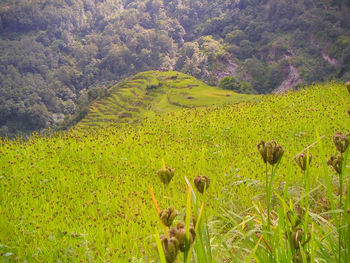
Rice
Rice is the seed of the monocot plants Oryza sativa or Oryza glaberrima . As a cereal grain, it is the most important staple food for a large part of the world's human population, especially in East Asia, Southeast Asia, South Asia, the Middle East, and the West Indies...
, that formed important parts of the prehistoric diet in Indian, Chinese Neolithic and Korean Mumun societies. Broomcorn (Panicum miliaceum) and foxtail millet
Foxtail millet
Foxtail millet is the second most widely planted species of millet, and the most important in East Asia. It has the longest history of cultivation among the millets, having been grown in China since sometime in the sixth millennium BC...
were important crops beginning in the Early Neolithic
Neolithic
The Neolithic Age, Era, or Period, or New Stone Age, was a period in the development of human technology, beginning about 9500 BC in some parts of the Middle East, and later in other parts of the world. It is traditionally considered as the last part of the Stone Age...
of China
China
Chinese civilization may refer to:* China for more general discussion of the country.* Chinese culture* Greater China, the transnational community of ethnic Chinese.* History of China* Sinosphere, the area historically affected by Chinese culture...
. For example, some of the earliest evidence of millet cultivation in China was found at Cishan
Cishan culture
The Cishan culture was a Neolithic Yellow River culture in northern China, based primarily around southern Hebei. The Cishan culture was based on millet farming, the cultivation of which on one site has been dated back 10,000 years...
(north) and Hemudu
Hemudu culture
The Hemudu culture was a Neolithic culture that flourished just south of the Hangzhou Bay in Jiangnan in modern Yuyao, Zhejiang, China. The site at Hemudu, 22 km north-west of Ningbo, was discovered in 1973...
(south). Cishan dates for common millet husk phytoliths and biomolecular components have been identified around 8300–6700 BC in storage pits along with remains of pit-houses, pottery, and stone tools related to millet cultivation. Evidence at Cishan for foxtail millet dates back to around 6500 BC. A 4,000-year-old well-preserved bowl containing well-preserved noodles made from foxtail millet and broomcorn millet was found at the Lajia
Lajia
Lajia is an archaeological site located in Minhe County, Haidong Prefecture in Northwest China's Qinghai province. Lajia is associated with the Qijia culture and was discovered by archaeologists in 2000. The site covers an area of around 200,000 square meters...
archaeological site in China
China
Chinese civilization may refer to:* China for more general discussion of the country.* Chinese culture* Greater China, the transnational community of ethnic Chinese.* History of China* Sinosphere, the area historically affected by Chinese culture...
.
Palaeoethnobotanists have found evidence of the cultivation of millet in the Korean Peninsula
Korean Peninsula
The Korean Peninsula is a peninsula in East Asia. It extends southwards for about 684 miles from continental Asia into the Pacific Ocean and is surrounded by the Sea of Japan to the south, and the Yellow Sea to the west, the Korea Strait connecting the first two bodies of water.Until the end of...
dating to the Middle Jeulmun pottery period
Jeulmun pottery period
The Jeulmun Pottery Period is an archaeological era in Korean prehistory that dates to approximately 8000-1500 BC.. It is named after the decorated pottery vessels that form a large part of the pottery assemblage consistently over the above period, especially 4000-2000 BC. Jeulmun means...
(c. 3500–2000 BC) (Crawford 1992; Crawford and Lee 2003). Millet continued to be an important element in the intensive, multi-cropping agriculture of the Mumun pottery period
Mumun pottery period
The Mumun pottery period is an archaeological era in Korean prehistory that dates to approximately 1500-300 BC This period is named after the Korean name for undecorated or plain cooking and storage vessels that form a large part of the pottery assemblage over the entire length of the period, but...
(c. 1500–300 BC) in Korea (Crawford and Lee 2003). Millets and their wild ancestors such as barnyard grass and panic grass were also cultivated in Japan
Japan
Japan is an island nation in East Asia. Located in the Pacific Ocean, it lies to the east of the Sea of Japan, China, North Korea, South Korea and Russia, stretching from the Sea of Okhotsk in the north to the East China Sea and Taiwan in the south...
during the Jōmon period
Jomon period
The is the time in Japanese prehistory from about 14,000 BC to 300 BC.The term jōmon means "cord-patterned" in Japanese. This refers to the pottery style characteristic of the Jōmon culture, and which has markings made using sticks with cords wrapped around them...
some time after 4000 BC (Crawford 1983, 1992).
Millet made its way from China to the Black Sea region of Europe
Europe
Europe is, by convention, one of the world's seven continents. Comprising the westernmost peninsula of Eurasia, Europe is generally 'divided' from Asia to its east by the watershed divides of the Ural and Caucasus Mountains, the Ural River, the Caspian and Black Seas, and the waterways connecting...
by 5000 BC. The cultivation of common millet as the earliest dry crop in East Asia has been attributed to its resistance to drought and this has been suggested to have aided its spread.
Major research on millets is carried out by the International Crops Research Institute for the Semi-Arid Tropics
International Crops Research Institute for the Semi-Arid Tropics
The International Crops Research Institute for the Semi-Arid-Tropics is a non-profit organization in India.It was founded in 1972 by a consortium of organizations convened by the Ford and the Rockefeller Foundations. Its charter was signed by the FAO and the UNDP...
in Andhra Pradesh
Andhra Pradesh
Andhra Pradesh , is one of the 28 states of India, situated on the southeastern coast of India. It is India's fourth largest state by area and fifth largest by population. Its capital and largest city by population is Hyderabad.The total GDP of Andhra Pradesh is $100 billion and is ranked third...
, India
India
India , officially the Republic of India , is a country in South Asia. It is the seventh-largest country by geographical area, the second-most populous country with over 1.2 billion people, and the most populous democracy in the world...
, and by the USDA-ARS
Agricultural Research Service
The Agricultural Research Service is the principal in-house research agency of the United States Department of Agriculture . ARS is one of four agencies in USDA's Research, Education and Economics mission area...
at Tifton, Georgia
Tifton, Georgia
Tifton is a city in Tift County, Georgia, United States. The population was 15,060 at the 2000 census. The city is the county seat of Tift County.-Major highways:* Interstate 75* U.S. Highway 41* U.S. Highway 82* U.S...
, USA
United States
The United States of America is a federal constitutional republic comprising fifty states and a federal district...
.
Production
India is the world's leading producer of millet.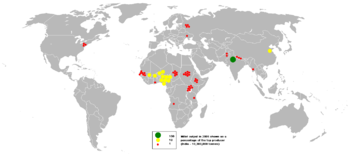
| Top millet producers — 2009 | ||||
|---|---|---|---|---|
| Country | Production (Tonne Tonne The tonne, known as the metric ton in the US , often put pleonastically as "metric tonne" to avoid confusion with ton, is a metric system unit of mass equal to 1000 kilograms. The tonne is not an International System of Units unit, but is accepted for use with the SI... s) |
Footnote | ||
| 8,810,000 | ||||
| 4,884,890 | ||||
| 2,677,860 | ||||
| 1,390,410 | ||||
| 1,225,579 | ||||
| 970,927 | ||||
| 841,000 | ||||
| 810,121 | ||||
| 708,695 | Im | |||
| 630,000 | ||||
| 560,030 | ||||
| World | 26,702,5359 | A | ||
| No symbol = official figure, Im = FAO data based on imputation methodology, A = May include official, semi-official or estimated data Source: Food And Agricultural Organization of United Nations: Economic And Social Department: The Statistical Division |
||||
Current uses of millet
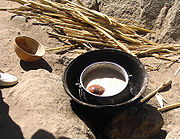
As a food source
Millets are major food sources in arid and semi-arid regions of the world, and feature in the traditional cuisine of many others. In Western India, SorghumSorghum
Sorghum is a genus of numerous species of grasses, one of which is raised for grain and many of which are used as fodder plants either cultivated or as part of pasture. The plants are cultivated in warmer climates worldwide. Species are native to tropical and subtropical regions of all continents...
(called Jowar, Jwaarie or Jondhahlaa in Gujarati
Gujarati language
Gujarati is an Indo-Aryan language, and part of the greater Indo-European language family. It is derived from a language called Old Gujarati which is the ancestor language of the modern Gujarati and Rajasthani languages...
, Hindi and Marathi
Marathi language
Marathi is an Indo-Aryan language spoken by the Marathi people of western and central India. It is the official language of the state of Maharashtra. There are over 68 million fluent speakers worldwide. Marathi has the fourth largest number of native speakers in India and is the fifteenth most...
languages, respectively, or Mutthaari or Kora in Malayalam
Malayalam language
Malayalam , is one of the four major Dravidian languages of southern India. It is one of the 22 scheduled languages of India with official language status in the state of Kerala and the union territories of Lakshadweep and Pondicherry. It is spoken by 35.9 million people...
), has been commonly used with millet flour (called "Bajari" in Western India) for hundreds of years to make the local staple hand rolled (that is, without a rolling pin) flat bread (called "Rotla" in Gujarati or "Bhakri
Bhakri
Bhakri is a round flat unleavened bread often used in the cuisine of western and central India, especially in the states of Rajasthan, Gujarat, Maharashtra, Malwa, Goa and northern Karnataka . It is coarser than a roti and can be compared to a British biscuit with respect to hardness.Bhakri as...
" in Marathi or Roti
Roti
Roti is generally a South Asian bread made from stoneground wholemeal flour, traditionally known as atta flour, that originated and is consumed in India, Pakistan, Bangladesh, Nepal and Sri Lanka. It is also consumed in parts of the Southern Caribbean, particularly in Guyana, Suriname, Trinidad and...
in other languages). Another cereal grain popularly used in rural and poor people to consume as staple in the form of roti or other forms is called Ragi in Karnataka or Naachanie in Maharashtra, with the popularly made Ragi Rotti
Ragi rotti
Ragi Rotti is a breakfast item unique to the state of Karnataka, India. It is mostly popular in the rural areas of Southern Karnataka. It is made of ragi flour. Ragi-Rotti means ragi-pancake in the native language, Kannada. It is prepared in the same way as Akki rotti. The ragi flour is mixed...
in Kannada. Ragi Mudde
Ragi mudde
Ragi mudde also Ragi Sangati is a wholesome meal in Karnataka and Rayalaseema region in India. It is mainly popular with the rural folk of Karnataka...
is a popular meal in Southern India. In Telugu it is called జోన౭లు (Jonnalu). Ragi is dark like rye but rougher in texture.
Millet porridge
Porridge
Porridge is a dish made by boiling oats or other cereal meals in water, milk, or both. It is usually served hot in a bowl or dish...
is a traditional food in Russian
Russian cuisine
Russian cuisine is diverse, as Russia is the largest country in the world. Russian cuisine derives its varied character from the vast and multi-cultural expanse of Russia. Its foundations were laid by the peasant food of the rural population in an often harsh climate, with a combination of...
, German and Chinese
Chinese cuisine
Chinese cuisine is any of several styles originating in the regions of China, some of which have become highly popular in other parts of the world – from Asia to the Americas, Australia, Western Europe and Southern Africa...
сuisines. In Russia it is eaten sweet (with milk and sugar added at the end of the cooking process) or savoury with meat or vegetable stews. In China it is eaten without milk or sugar, frequently with beans, sweet potato, and/or various types of squash; millet soup is commonly used by nursing mothers to aid in milk production and healing from childbirth. In Germany it is also eaten sweet (boiled in water with apples added during the boiling process and honey added during the cooling process).
People with cœliac disease
Coeliac disease
Coeliac disease , is an autoimmune disorder of the small intestine that occurs in genetically predisposed people of all ages from middle infancy onward...
can replace certain gluten-containing cereals in their diets with millet.
Millets are also used as bird and animal feed.
Alcoholic beverages
Millets are traditionally important grains used in brewing millet beerMillet beer
Millet beer, also known as Bantu beer, kaffir beer, or opaque beer, is an alcoholic beverage made from malted millet. This type of beer is common throughout Africa. Related African drinks include maize beer and sorghum beer....
in some cultures, for instance by the Tao people
Tao people
The Tao , originally recognized as Yami , are a Taiwanese aboriginal people, native to tiny outlying Orchid Island in Taiwan. The Tao are an Austronesian people linguistically and culturally closer to the Ivatan people of the Batanes islands in the Philippines than to other aboriginal peoples on...
of Orchid Island
Orchid Island
Orchid Island is a 45-km² volcanic island off the southeastern coast of Taiwan island and separated from the Batanes of the Philippines by the Bashi Channel of the Luzon Strait. It is governed as Lanyu Township of Taitung County...
, Taiwan, and, along with sorghum
Sorghum
Sorghum is a genus of numerous species of grasses, one of which is raised for grain and many of which are used as fodder plants either cultivated or as part of pasture. The plants are cultivated in warmer climates worldwide. Species are native to tropical and subtropical regions of all continents...
, by various peoples in East Africa. It is also the base ingredient for the distilled liquor rakshi in Nepal and the indigenous alcoholic drink of the Sherpa, Tamang, and Limbu people, tongba
Tongba
Tongba is a millet-based alcoholic beverage found in the far eastern mountainous region of Nepal and the neighbouring Darjeeling and Sikkim districts of India. It is the traditional and indigenous drink of the Limbu people of eastern Nepal....
, in Eastern Nepal. In Balkan
Balkans
The Balkans is a geopolitical and cultural region of southeastern Europe...
countries, especially Romania and Bulgaria, millet is used to prepare the fermented drink boza
Boza
Boza, also bosa , is a popular fermented beverage in Kazakhstan, Turkey, Kyrgyzstan, Albania, Bulgaria, Macedonia, Montenegro, Bosnia and Herzegovina, parts of Romania, Serbia, Ukraine and also Poland and Lithuania...
.
Other uses
Millet, along with birdseed, is commonly used as fillings for jugglingJuggling
Juggling is a skill involving moving objects for entertainment or sport. The most recognizable form of juggling is toss juggling, in which the juggler throws objects up to catch and toss up again. This may be one object or many objects, at the same time with one or many hands. Jugglers often refer...
beanbags.
Millet is widely popular as a treat/food for the domesticated pet
Pet
A pet is a household animal kept for companionship and a person's enjoyment, as opposed to wild animals or to livestock, laboratory animals, working animals or sport animals, which are kept for economic or productive reasons. The most popular pets are noted for their loyal or playful...
Parakeet
Parakeet
Parakeet is a term for any one of a large number of unrelated small to medium sized species of parrot, that generally have long tail feathers...
/Budgerigar
Budgerigar
The Budgerigar , also known as Common Pet Parakeet or Shell Parakeet informally nicknamed the budgie, is a small, long-tailed, seed-eating parrot, and the only species in the Australian genus Melopsittacus...
.
Nutrition
The protein content in millet is very close to that of wheatWheat
Wheat is a cereal grain, originally from the Levant region of the Near East, but now cultivated worldwide. In 2007 world production of wheat was 607 million tons, making it the third most-produced cereal after maize and rice...
; both provide about 11% protein by weight.
Millets are rich in B vitamins, especially niacin
Niacin
"Niacin" redirects here. For the neo-fusion band, see Niacin .Niacin is an organic compound with the formula and, depending on the definition used, one of the forty to eighty essential human nutrients.Niacin is one of five vitamins associated with a pandemic deficiency disease: niacin deficiency...
, B6 and folic acid
Folic acid
Folic acid and folate , as well as pteroyl-L-glutamic acid, pteroyl-L-glutamate, and pteroylmonoglutamic acid are forms of the water-soluble vitamin B9...
, calcium
Calcium
Calcium is the chemical element with the symbol Ca and atomic number 20. It has an atomic mass of 40.078 amu. Calcium is a soft gray alkaline earth metal, and is the fifth-most-abundant element by mass in the Earth's crust...
, iron
Iron
Iron is a chemical element with the symbol Fe and atomic number 26. It is a metal in the first transition series. It is the most common element forming the planet Earth as a whole, forming much of Earth's outer and inner core. It is the fourth most common element in the Earth's crust...
, potassium
Potassium
Potassium is the chemical element with the symbol K and atomic number 19. Elemental potassium is a soft silvery-white alkali metal that oxidizes rapidly in air and is very reactive with water, generating sufficient heat to ignite the hydrogen emitted in the reaction.Potassium and sodium are...
, magnesium
Magnesium
Magnesium is a chemical element with the symbol Mg, atomic number 12, and common oxidation number +2. It is an alkaline earth metal and the eighth most abundant element in the Earth's crust and ninth in the known universe as a whole...
, and zinc
Zinc
Zinc , or spelter , is a metallic chemical element; it has the symbol Zn and atomic number 30. It is the first element in group 12 of the periodic table. Zinc is, in some respects, chemically similar to magnesium, because its ion is of similar size and its only common oxidation state is +2...
. Millets contain no gluten
Gluten
Gluten is a protein composite found in foods processed from wheat and related grain species, including barley and rye...
, so they are not suitable for raised bread. When combined with wheat
Wheat
Wheat is a cereal grain, originally from the Levant region of the Near East, but now cultivated worldwide. In 2007 world production of wheat was 607 million tons, making it the third most-produced cereal after maize and rice...
, (or xanthan gum
Xanthan gum
Xanthan gum is a polysaccharide, derived from the bacterial coat of Xanthomonas campestris, used as a food additive and rheology modifier, commonly used as a food thickening agent and a stabilizer...
for those who have cœliac disease), they can be used for raised bread. Alone, they are suited for flatbread
Flatbread
A flatbread is a simple bread made with flour, water, and salt and then thoroughly rolled into flattened dough. Many flatbreads are unleavened: made without yeast or sourdough culture: although some flatbread is made with yeast, such as pita bread....
.
As none of the millets are closely related to wheat, they are appropriate foods for those with cœliac disease or other forms of allergies/intolerance of wheat. However, millets are also a mild thyroid peroxidase
Thyroid peroxidase
Thyroid peroxidase or thyroperoxidase is an enzyme expressed mainly in the thyroid that liberates iodine for addition onto tyrosine residues on thyroglobulin for the production of thyroxine or triiodothyronine , thyroid hormones. In humans, thyroperoxidase is encoded by the TPO...
inhibitor and probably should not be consumed in great quantities by those with thyroid disease
Thyroid disease
-Hyper- and hypofunction:Imbalance in production of thyroid hormones arises from dysfunction of the thyroid gland itself, the pituitary gland, which produces thyroid-stimulating hormone , or the hypothalamus, which regulates the pituitary gland via thyrotropin-releasing hormone . Concentrations of...
.

